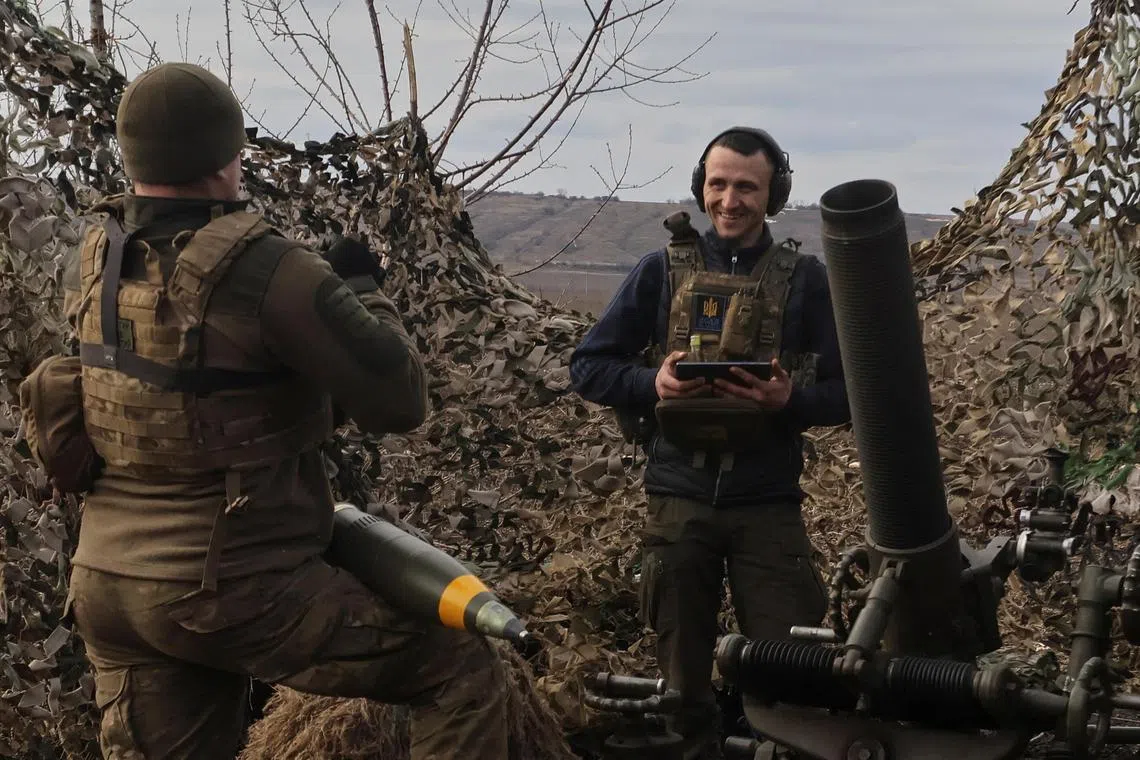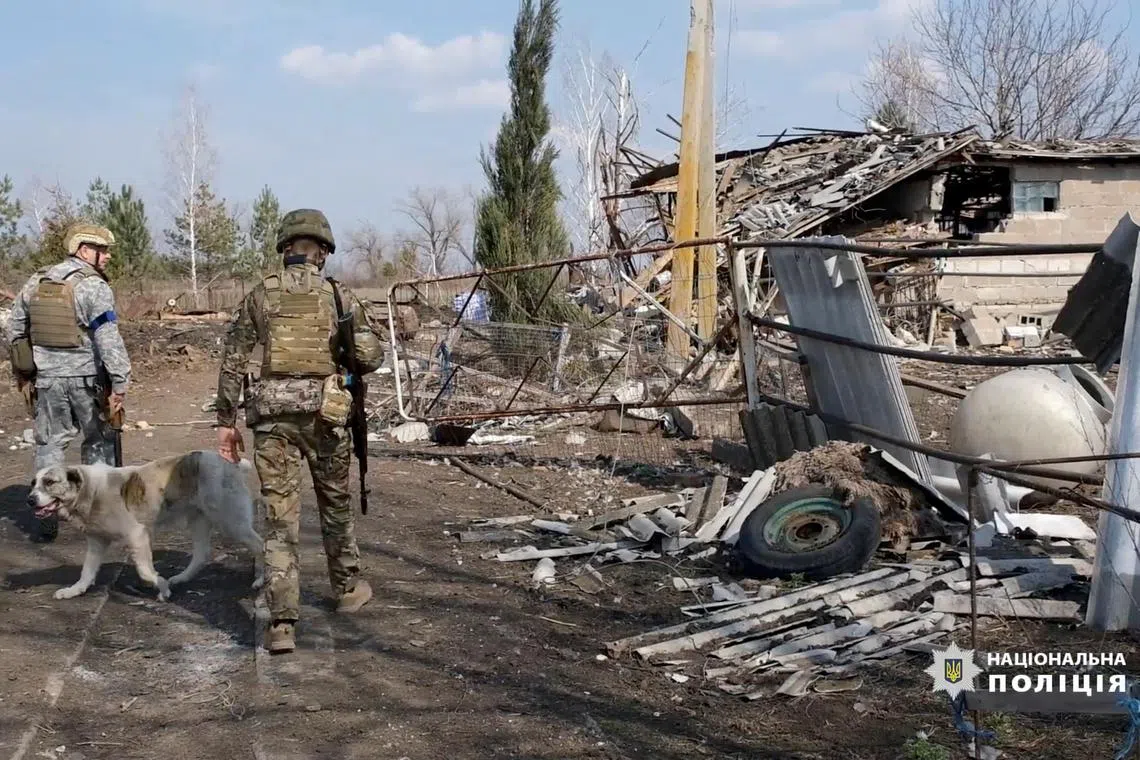Bracing for fights ahead, Russia and Ukraine step up military recruitment
Sign up now: Get ST's newsletters delivered to your inbox

The Ukrainian government has reached into all levels of society, supplying a steady stream of motivated soldiers.
PHOTO: REUTERS
Follow topic:
MOSCOW - Their soldiers battling and dying across muddy trenches, ruined towns and sprawling minefields, Russia and Ukraine have stepped up recruitment drives to bolster their badly depleted militaries, in another sign that both sides are steeling themselves for a long war.
President Vladimir Putin of Russia signed a decree on Thursday authorising a larger-than-normal spring draft, with a target of about 147,000 men, about 10 per cent more than the goal of Russia’s 2022 spring drive.
Although the new recruits are unlikely to go to the battlefield immediately – one Russian official claimed they would not be sent there at all – the draft will create a bigger pool of potential troops for Russia’s army, which has suffered immense casualties.
Ukraine, also trying to replenish its ranks, said it had received more than 35,000 applications for a new force it is forming, the Offensive Guard.
For several weeks, trying to entice volunteers, Ukraine’s government has plastered posters and billboards across the country and advertised its plan for a network of combat brigades meant to work under the Interior Ministry alongside the regular armed forces.
The moves to rebuild Russia and Ukraine’s battered militaries came alongside other signals that the countries, along with their supporters, are digging in on their respective sides. Kremlin spokesman Dmitry Peskov said on Friday that a Belarusian call for an immediate ceasefire in Ukraine would not affect Russia’s military.
“Nothing changes in the context of Ukraine, the special military operation continues, because it is the only means of achieving the goals that our country has today,” he told reporters, according to Russian and Western news services.
The Russian authorities’ detention on Thursday of an American journalist on accusations of espionage was widely interpreted in the West as a ploy to exert pressure on the United States, and the President of Belarus Alexander Lukashenko, echoing Mr Putin, warned on Friday about the prospect of nuclear war.
Finland, meanwhile, cleared its last obstacle to joining the North Atlantic Treaty Alliance, bringing the alliance’s territory right up to a long stretch of Russia’s border.
All the while, more deliveries of Western weapons are arriving in Ukraine, where officials say they will soon launch a counter-offensive to reclaim territory lost in the east and south.
Russia’s own recent offensive has struggled to make gains in eastern Ukraine, and Western analysts debate whether the Russian military, after suffering staggering casualties, is capable of mounting another or resisting a Ukrainian attack.
Neither Ukraine nor Russia disclose their own casualty numbers, but Western officials and analysts say both have suffered huge losses in their militaries.
American officials estimate that about 200,000 Russian soldiers have been killed or wounded since the full-scale invasion began in February 2022,
The recent weeks of vicious battle in the east, in particular, in cities and towns like Bakhmut and Avdiivka, have cost Ukraine large numbers of troops, including some of its most experienced fighters.

Police officers walk near damaged buildings, amid Russia’s attack on Ukraine, in Avdiivka, Donetsk region, on March 28.
PHOTO: REUTERS
US officials said last month that, at times, hundreds of Ukrainian troops were being wounded or killed each day.
Since Russia invaded, the Ukrainian government has reached deep into all levels of society to fill the ranks, supplying a steady stream of motivated soldiers, in contrast to Russia’s mix of contract soldiers, draftees, convicts and mercenaries.
Twice a year, including starting in April, the Russian military conscripts young men for one year of training and service.
Even when his army had exhausted its reserves during months of fighting last year, Mr Putin resisted a broader national draft for much of 2022, only ordering a “partial” mobilisation of about 300,000 men in September
That draft drove tens of thousands of Russian men to flee the country, and many of those who were recruited were quickly sent into the war, which the Kremlin still refers to as a “special military operation”.
Although he has quashed dissent within Russia, Mr Putin remains sensitive to public opinion, and has faced periodic outrage from relatives of soldiers and sailors – for instance, after the sinking of Russia’s Black Sea flagship in the spring and during the haphazard draft last fall.
This week, Russian officials appeared to try to tamp down concerns that the newest recruits would soon wind up in the fighting.
“Not one serviceman called up will be sent to the zone of the special military operation,” rear-admiral Vladimir Tsimlyansky, who is on the Russian military’s General Staff, told Russian state television on Friday.
“The number of contract servicemen and mobilised servicemen is fully sufficient to resolve the objectives set before us.”

A wounded Ukrainian seviceman is being carried away from the front line near Bakhmut, on March 23.
PHOTO: AFP
Russia continues to rely on reservists, experienced soldiers and convicts who were eager to get out of prison to fight its war in Ukraine. But the authorities have urged some conscripts to stay in the military after their year of mandatory service, offering cash bonuses as an incentive.
The Kremlin has also tried to ramp up pressure on Ukraine’s Western supporters, but its options for doing so have narrowed over 13 months of war. Europe has largely weaned itself from reliance on Russian gas and oil, and Moscow has not followed up on often vague vows of retribution.
Less than a week after Mr Putin said he would position nuclear weapons in neighbouring Belarus, the Belarusian President on Friday joined his close ally in raising the prospect of nuclear war.
Mr Lukashenko told Belarusian lawmakers that “a third world war loomed on the horizon with nuclear fires”.
Mr Putin has repeatedly raised the spectre of using nuclear weapons, a prospect that many analysts view as bluster aimed at igniting fear and pressuring Western leaders to halt the delivery of arms to Ukraine.
But Mr Lukashenko, although almost entirely dependent on Russia for economic, political and security assistance, has also resisted a complete embrace of the Kremlin’s ambitions.
Despite allowing Russia’s military to use Belarus as a staging ground for the full-scale invasion of Ukraine last year, he has so far refrained from sending his own soldiers to help Russia on the battlefield. NYTIMES

